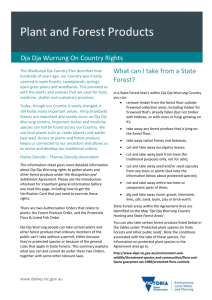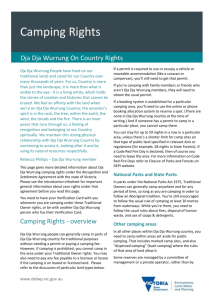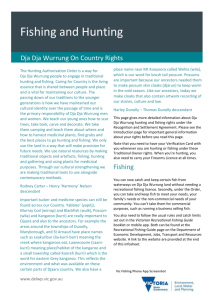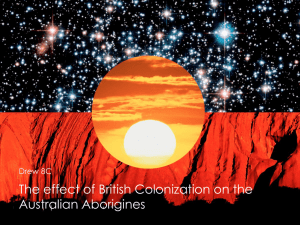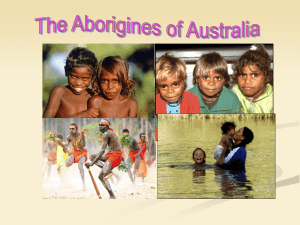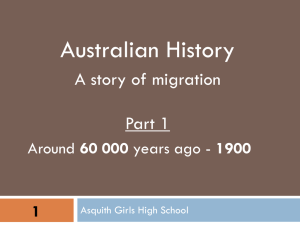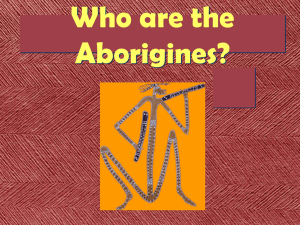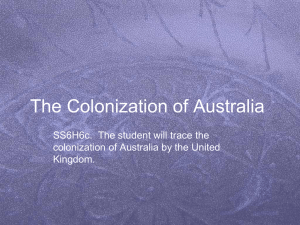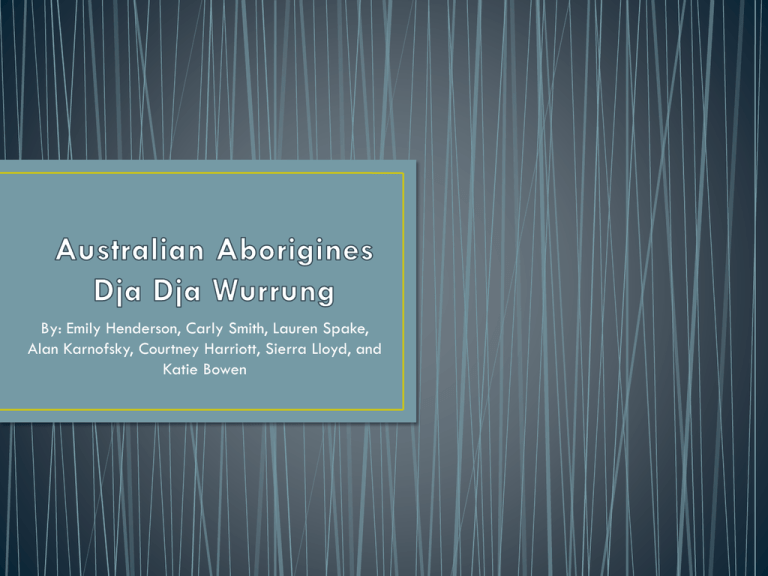
By: Emily Henderson, Carly Smith, Lauren Spake,
Alan Karnofsky, Courtney Harriott, Sierra Lloyd, and
Katie Bowen
“Australian aboriginal culture can claim to be the oldest continuous living culture on the
planet”
• Recent archeological finds have found
that there has been Aboriginal
presence in Australia for at least
40,000 years. Some of the evidence
dates to over 60,000 years old.
• The main belief of Aboriginal culture is
'oneness with nature'.
• Environment is the core of what
Australian Aborigines hold sacred.
• Nature and landscape in this culture
are of comparable importance to the
bible in Christianity
• The first Australian aborigines settled and colonized what is now
Papa New Guinea or Indonesia
• Traditional aborigines lived a nomadic lifestyle, following
seasons and opportunities for food
• It is said aborigines hunted large game to extinction in the
outback
• This is possibly how they learned to take care of their natural
resources and move to new hunting grounds before they
destroyed all natural environment
• Hunting and Gathering Society
• Located along the Loddon, Campaspe, and Avoca Riverine
region of central/western Victoria, Australia. Bendigo is the
largest city in Dja Dja Wurrung country
• The society has been in existence since at least 1788
• This year is marked by when the first European settlers came to the region
• It is likely that they had lived there for sometime before but there are no
existing records that specify the exact time period
• Total Population: 2,500
• Regions with Significant
Populations: Bendigo is the
largest city and other ones
include Wedderburn,
Castlemaine, St. Arnaud,
Maryborough, Boort,
Heathcote and Maldon.
• Also includes areas of the
Loddon, Campaspe and
Avoca Rivers in the Riverine
region of central/western
Victoria, Australia.
• In 1789 and 1825, evidence has shown that there was an epidemic
of smallpox that would have killed a significant portion of the
population.
• From the late 1830s on, the European settlers introduced numerous
diseases to the Dja Dja Wurrung population, causing many deaths.
• Mortality rates also worsened during the gold rushes in 1851
• By December 1852 there were only about 142 people left (15 years
before there was between one and two thousand)
• In 1864, they resettled elsewhere and at this time there were only 31
adults and 7 children.
• Conflict between European settlers and Aborigines women over
sexual relations which was mistaken as prostitution
• Abduction and rape of these women was also very common and led
to violence
• The widespread abuse of the women lead directly to an epidemic of
venereal disease of syphilis and gonorrhea
• By 1841, it was estimated that 90% of women were suffering from
these diseases causing them to become infertile or to infect the
newborns leading to a high infant mortality rate and a large
decrease in birth rate.
• Birth control was obviously not an issue due to these factors even
though rape was very common.
• Europeans settled in Western Victoria in the 1830s and 1840s
• Resistance by the Dja Dja Wurrung people led to conflict
• Numerous massacres from 1838 to 1846 in which many of the Dja
Dja Wurrung people died
• This conflict with the Europeans caused two waves of settlement and
dispossession: one in 1837 and one in 1845.
• Europeans regarded them as heathens and they could not be
protected or testify against themselves in court so most of these
massacre cases were dismissed.
• In 1864, the few remaining people at the crown land of Franklinford
were forced to resettle at Coranderrk station
• In 2004, the crown land of Franklinford was reoccupied by an elderly
Dja Dja Wurrung.
• Unwanted trespassers were subjected to being attacked with
spears
• However, when some foreigners passed through a ceremony
was performed
• The ceremony of Tanderrum (freedom of the bush)
• This allowed safe passage and temporary access/use of land and
resources by foreign people.
• No set “ruler” or king in Dja Dja Wurrung clans
• Not structured in a hierarchy
• Older men and women held the greatest authority
• People worked in groups and shared leadership
• If there was an issue between clans then an informative council
(consisting of elder men) would be put together to solve the
conflict
• Legal System: explained through The Dreaming
• Establishes social, moral, and religious values, which were taught daily
through the use of music, song, dance, and storytelling.
• If a law was broken, “The Dreaming” would seek revenge on you.
• Fear of The Dreaming
•
•
•
•
Aboriginal society was not structured in a hierarchy
People worked in groups and shared the leadership
When disagreements arose, a headman sorted it out
The headman position was passed down from father to son as
they shared a link to a common ancestor
• If there was an issue concerning the general community an
informal council was formed and usually consisted of only men
• The Kulin society was made up of 16 clans, each with their own
headman
• The Jaara are one of these clans
• Began in 1788
• Thomas Mitchell was probably the first white man to be seen in Dja Dja
wurrung country
• European settlement of western Victoria in the 1830s in 1840s was marked
by resistance
• Led to massive massacres as well as the emergence of new diseases brought
by the Europeans which decimated the Aborigines’ population
• By 1940s almost all aborigine groups were assimilated into
Australian urban society as low-paid workers
• In 1976 and 1993 the government passed legislation returning a
certain degree of aborigine autonomy and native title rights
• However, their life expectancy and standard of living is not even
comparable with the average Australian
• The Dja Dja Wurrung were a
hunting and gathering society
therefore technology consisted of
man made items using natural
resources for food gathering
• Evidence through scarred trees shows
that the Jaara fashioned canoes from
the bark of trees so to go and raid
duck and other birds nests along the
Loddon River
• Tree bark was also used to make
shelters, shields, and coolamons
• Also it is likely that other weapons like
spears and bow and arrows were
used to hunt as well
• The Dja Dja Wurrung clan was located near the Loddon, Avoca,
and Campaspe rivers
• These rivers provided much of their food sources
• Diversity of foods: birds, other animals as well as plants
• Plants were a mainstay because of so many different types
• Myrmong, Cumbungi, Wardoo
• These rivers were part of established trade networks set up by
the Europeans which allowed goods and information to travel
over substantial distances
• Therefore, the Jaara was influenced by these routes as well as
the Europeans themselves
• The emergence of gold exploration in 1851 heavily impacted the Dja
Dja Wurrung as well as the rest of the world
• Bendigo was “center of the world” at the time due to many settlers
aspirations to make it big off the gold rush
• The gold rush placed more pressure on the Jaara
• 10,000 diggers were occupying their native lands and turning sacred ground
into gold digging sites
• The gold rush also caused a crisis in agricultural labor because so many
squatters were hiring the Jaara as servants
• In the end many were forced to move north because they were against living
on the margin of white society and the disrespectful thing like drinking and
prostitution that resulted
• Some forced to resettle at Coranderrk Reserve
• Australian aboriginal mythology and Christianity
• Totemism
• System of belief in which humans are said to have kinship or a mystical relationship
with a spirit-being, such as an animal or plant
• The spiritual being is symbolized in a totem through which the people can show their
respect
• Sex Totemism
• Characterized by the belief that a natural species is associated with each sex
• Eg. Bat for men/ wren for women
• But they believe that a common life is shared by both men and women and natural
species
• The Jaara place a lot of emphasis on their cultural and religious beliefs,
many of which overlap each other
• These beliefs govern relationships among people, marriage systems, and religious
practices
• States that:
• There is a belief in powerful beings who arouse from the land to create
people, plants, and animals
• Totemism- the belief that there is a genealogical relationship between
people and species of plants and animals
• Aspects of the Dreaming were passed on through the use of music, song,
dance, and storytelling.
• This was a common belief system amongst many aborigine tribes
• The Jaara People strongly believed in working together as a tribe
• Elders of the tribe were held in high esteem and were very respected
• The elders were also the leaders more or less
• The Jaara used a different system for names, like when referring to your
grandfather, in comparison to the names we use today
•
•
•
•
•
Aunty/uncle: address for older people, to whom the speaker may not be related.
Brother /sister : children of ones mother's sister and of father's brother
Cousin-brother / cousin-sister: children of ones mother's sister and father's brother
Cousin: any relative of one's own generation.
Father and mother: any relative of one's parents' generation, such as uncles, aunts, and
in-laws.
• Grandfather and grandmother: anyone of one's grandparents' generation. Grandfather
can also refer to any respected elderly man, to whom the speaker may not be related.
• Patrilineal System
• System in which one belongs to the father’s lineage; involves heritage of
property, names/titles through the male line
• The Jaara people have two moieties: Bunjil, the eagle, and
Waa, the crow
• Moieties are the division of society into groups based on decent
• The moieties define how society relates to one another, practices religion,
and sets up rules for marrying
• Language groups
• The Aboriginal society is broken into individual clans/ tribes within a
society
• For example, the Dja Dja Wurrung is a specific language group within the
Kulin society
• A skin group is a section that is determined by the skin of a person's
parents, and determine who a person is eligible to marry
• Every member of society is assigned a skin group even if one is not of
blood relation they are assigned a group based on which group they
have spent the most time with
• These groups define not only the rules for marriage but also how
daily relations are to be handled within the clan
• For example, some clan members can not talk to others as a sign of respect
(often refers to elders) and if something must be relayed to a member that
one could not approach a third party would have to mediate
• Children are taught these rules so that when they become adults they will
know how to handle situations
• Founded by Edward Stone Parker to protect aborigines from
oppression, violations on their land, and acts of cruelty
• The Franklinford Common School:
•
•
•
•
Built in mid 1860s as a mud hut
Later used for children of settlers & renovated into brick
Ruled unfit for teaching
Forced to close in February 1848
• Children relocated to Coranderrk
• Were not believed to be capable of the same educational
standards as the children of European settlers
• Only taught the first half of primary-school curriculum
• Poorly trained teachers who did not know of the cultural and
environmental differences between the Europeans and the
Aborigines
• Parents of Aborigine children were not supportive
• In response to sociological research and
enlightened public opinion
• properly trained teachers
• public or independent schools
• same curriculum as other schools
• Goal: prepare children for association
(assimilation)
• Taught English
• Opportunities have greatly improved
• More Aborigines going to school and staying for
longer
• More universities, vocational training
• The Jaara have a Catholic secondary school on their
territory: The Catholic College Bendigo
• Restrictions
• Patriarchal System
• Married women were required to live with their
husbands family.
• Relationships and obligations were structured
around Kinship System.
• Families
• Usually Consisted of a man his wife/wives and
children.
• Kinship system required that parents provide food
for children and supplying their personal needs.
• Uncles and Aunts were responsible for children's
punishment and education.
• Marriage
• “A family group can be quite large, consisting of a man and his wives, the
children from each wife, and sometimes his parents or in-laws. A man
often had from two to four wives, ranging form one to more than ten”
- Aboriginalculture.com
• After colonization men seemed to only have one wife.
• Ceremonies and exchange of goods.
• Bride and groom are required to purchase gifts and give one to every
person that attends wedding.
1. Who was in charge of sorting out disagreements within the
tribe?
a.
b.
c.
d.
The Women
The Headman
The Europeans
The Chief
2. The Jaara use a specific kinship system where one’s lineage is
traced through the father’s line. What is this system called?
a.
b.
c.
d.
Patrilineal System
Matrilineal System
Ambilineal System
Unilineal System
3. Why did the Jaara people quit attending the Franklinford Common School?
a.
b.
c.
d.
It burned down in a fire and was not rebuilt
It was converted into a church to be used by the European settlers
The school was forced to close because it was deemed unfit for teaching
A nearby school was opened and they went there instead
4. What was the main factor that led to the population decline of the Dja Dja
Wurrung people?
a.
b.
c.
d.
e.
An epidemic of venereal disease causing women to become infertile
Epidemics of smallpox
Introduction of new diseases by European settlers
Gold rushes
All of the above
5. What is the main belief of Aboriginal culture?
a.
b.
c.
d.
e.
Oneness with land
Oneness with your soul
Oneness with nature
Oneness with one’s tribe
Oneness with Europeans
Answer Key:
1. B
2. A
3. C
4. E
5. C
•
•
•
•
http://en.wikipedia.org/wiki/Dja_Dja_Wurrung
http://en.wikipedia.org/wiki/Coranderrk
http://en.wikipedia.org/wiki/Franklinford,_Victoria
http://www.onmydoorstep.com.au/heritagelisting/507/former-franklinford-common-school
• http://www.ccb.vic.edu.au/home/about/
• Berndt, Catherine and Ronald. The Aboriginal Australians.
Pitman Publishing, Victoria: 1983.
• The Australian Aborigines. The Department of Territories,
Sydney: 1967.
• http://www.indigenousaustralia.info/socialstructure/kinship.html
• http://gamahucherpress.yellowgum.com/books/religion/pre_co
ntact_aborigines.pdf
• http://austhrutime.com/kinship_systems.htm
• http://en.wikipedia.org/wiki/Dja_Dja_Wurrung
• http://en.wikipedia.org/wiki/Australian_Aboriginal_kinship
• www.absoluteastronomy.com/topics/Dja_Dja_Wurrung
• www.nccma.vic.gov.au/library/scripts/objectifyMedia.aspx
• http://en.wikipedia.org/wiki/Scarred_tree


